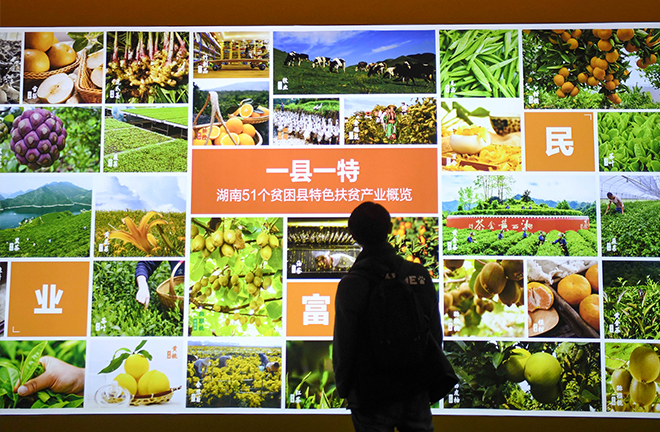Making the ideal of common prosperity a reality

A visitor watches photos that illustrate achievements of poverty alleviation in 51 counties that were formerly under the poverty line in Hunan Province. Photo: Yang Huafeng/CNSphoto
Common prosperity is not only an ideal but also an accessible reality. When people discussed common prosperity in the initial period, when the reform and opening up had just been implemented, this great goal seemed far away and unreachable. That period’s main task was to eliminate material shortage and poverty. People’s understanding of common prosperity was also relatively shallow, and many thought that it would be a miracle if their material and spiritual life reached only a moderately prosperous level.
As China made great achievements over the past 40+ years of reform and opening up, it became a normal phenomenon for people to become wealthy through their hard work and innovative ideas. The goal of common prosperity is thus of more realistic significance today, compared with the past.
However, before achieving common prosperity in the real sense, some contradictions and problems appear and are becoming increasingly prominent, which requires deep understanding and active engagement.
Misunderstandings of the goal
As some groups attain wealth first, and others later, it is inevitable that an income gap exists between groups, sectors, and regions. Since common prosperity should be the prosperity of all people, and not of minor groups, the income gap must be narrowed. However, some people mistakenly think they should “not worry about material shortage but about inequality of distribution.” In their minds, common prosperity is easily understood as egalitarianism, wherin resources are distributed in a uniform way. Obviously, it is very difficult for any society to achieve absolutely equal prosperity. Such a goal of common prosperity is not only unattainable, but also will disrupt the common wealth path that we pursue.
In addition, common prosperity should be understood as prosperity in all aspects. In many cases today, a person’s success is measured by the amount of material wealth he/she possesses. Such a perspective of wealth, and narrow concept of success, will contribute no progress toward achieving common prosperity in the real sense, and will lead some young people astray and possibly distort their lifestyles, values, and world views. Common Prosperity not only means a rich material life, but also a rich intellectual life, one which emphasizes the spirit of self-reliance.
At last, it is important to note that common prosperity should be pursued at a gradual pace. Some people, who are eager for quick success and instant profit, desire overnight success. In view of this, we must realize that pursuing common prosperity for all the people is an arduous task, and the process needs to be advanced step-by-step.
Enlarging the middle-income group
In the 10th Session of the Financial and Economic Commission of the Central Committee of the Communist Party of China (CPC), it was pointed out that an oval distribution structure, which is small at both ends but large in the middle, should be formed in society. It is considered an ideal distribution structure for modern society in which the middle-income group takes the largest proportion and low-income and high-income groups take a minor part. For a country, if the middle-income group is the mainstay of the whole income structure, there will be a narrow income gap and convergent interest among different groups, which means few social contradictions and greater social stability. A growing middle-income group integrates the opposite poles of the rich and the poor in a coherent order, so that each social member can hope to ascend the ladder of wealth. This is helpful as it relieves antagonism caused by the income gap and resulting social problems.
To enlarge the middle-income group, targeted measures need to be taken. It is important to properly deal with the relationship between efficiency and equity. The tools of taxation, social security, and transfer payments can be better utilized in adjusting income. The government should also promote equal access to basic public services, and increase investment in human capital resources to benefit the public in a universal way. It is also necessary to encourage high-income groups and enterprises to voluntarily pay back society. In addition, income that is earned in an irrational way should be regulated.
Wu Yin is a professor from the School of Economics at the Southwest University of Finance and Economics.
Edited by BAI LE
